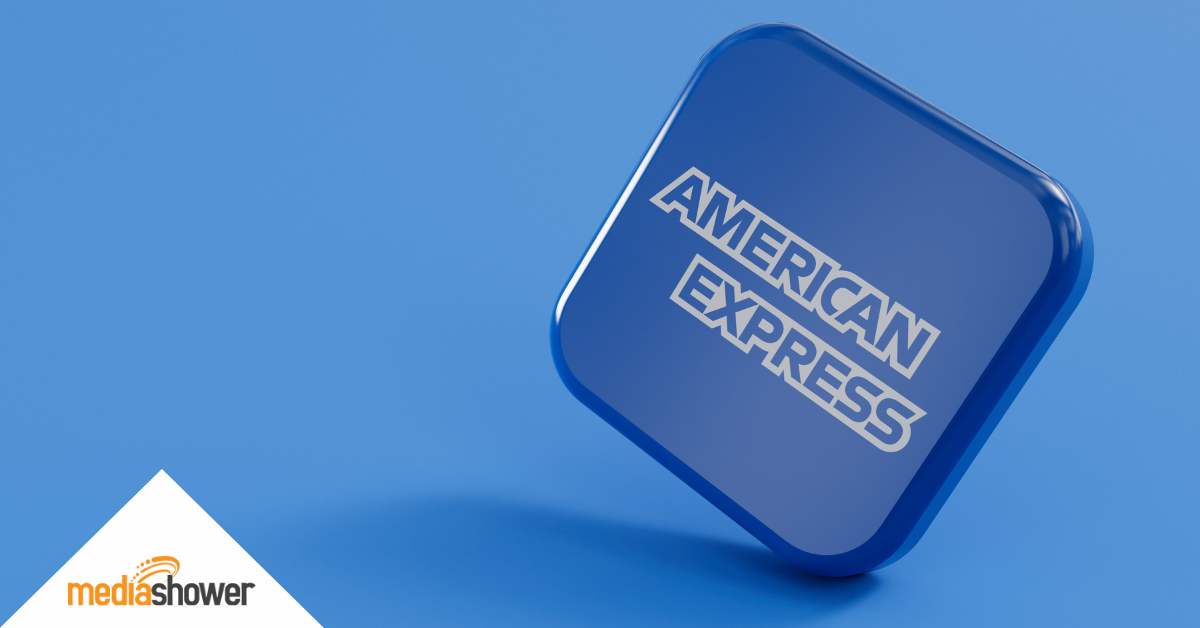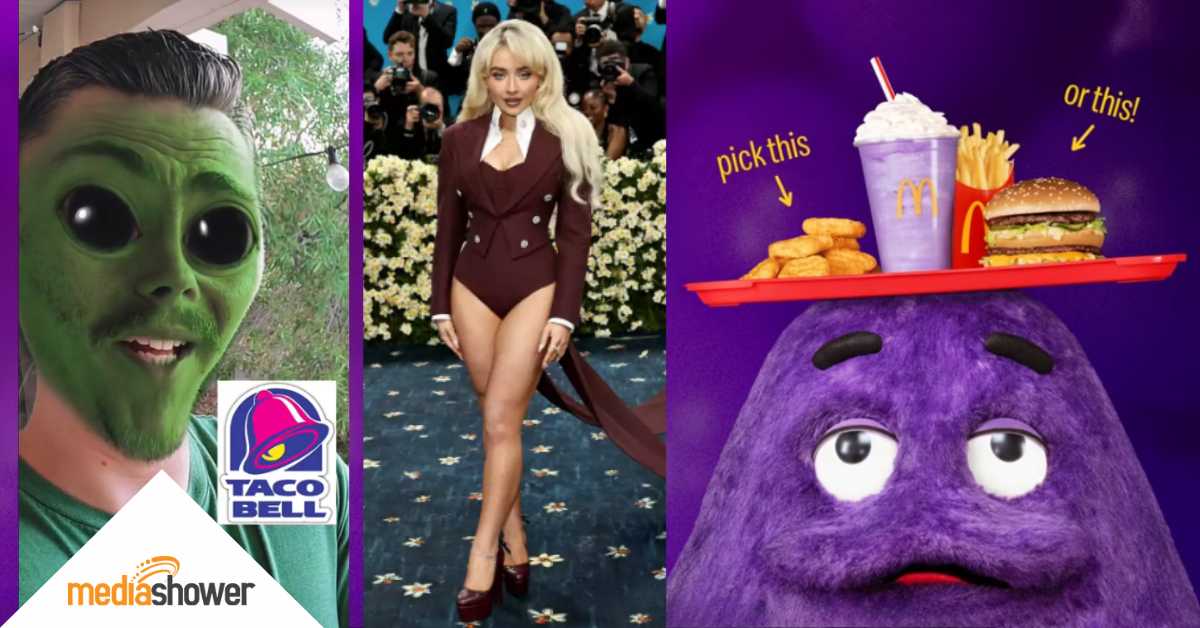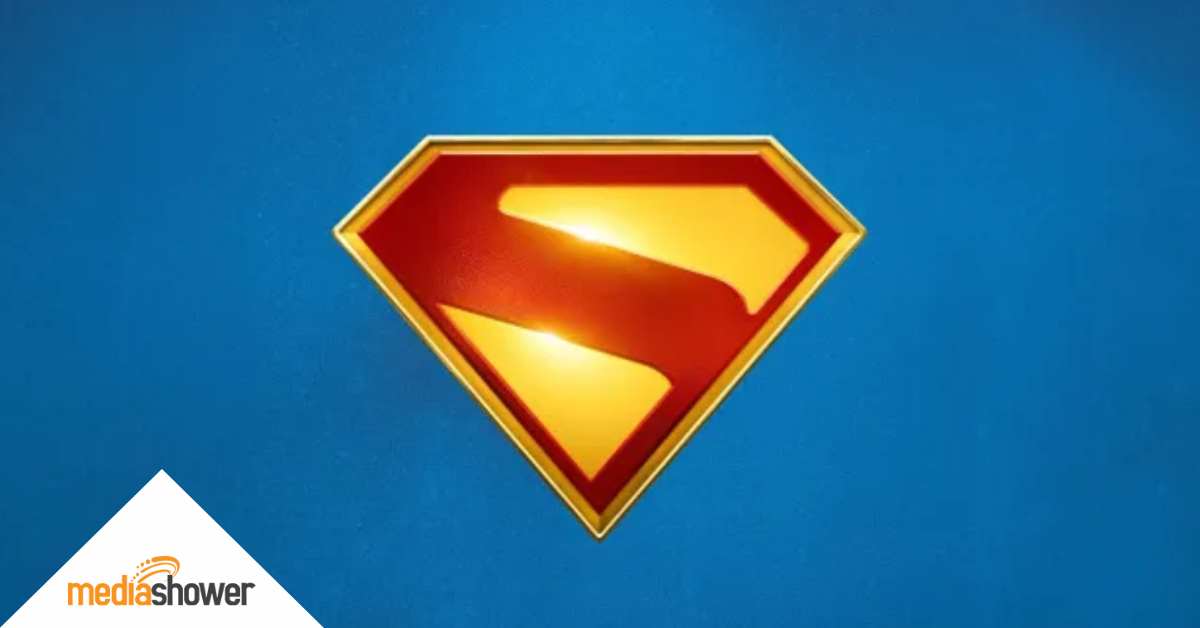
Quick Summary
- From 10-cent comic to billion-dollar brand. Superman’s 86-year marketing journey shows how strategic adaptation and cross-media mastery built an unstoppable cultural force.
- Cross-platform pioneer. Before “omnichannel” was a buzzword, Superman dominated comics, radio, TV, film, and merchandising with coordinated campaigns.
- Merchandising powerhouse. From Kellogg’s cereal boxes to LEGO sets, Superman proved character licensing could generate massive revenue streams.
- Cultural chameleon. Each era’s Superman reflected contemporary values—from WWII propaganda hero to post-Vietnam symbol of hope.
It’s a billion dollar brand – but it started in a ten-cent comic book.
Superman, the first modern superhero and a blueprint for brand-building, didn’t just leap tall buildings. He launched from newsstands to radio waves, from cereal boxes to Saturday morning cartoons, and from prime-time television to movie theaters and LEGO sets—creating a playbook for multi-generational brand dominance along the way.
That legacy is still paying off. The weekend of July 11-13, 2025, James Gunn’s Superman opened to a global debut of $217 million. It’s the best opening yet for a solo Superman film: not bad for a genre that’s been experiencing superhero fatigue.
As the newest Superman film hits theaters, we’re revisiting how a caped alien from Krypton became one of the most recognizable and commercially successful icons in history. His journey is a masterclass in strategic marketing that still offers lessons today.
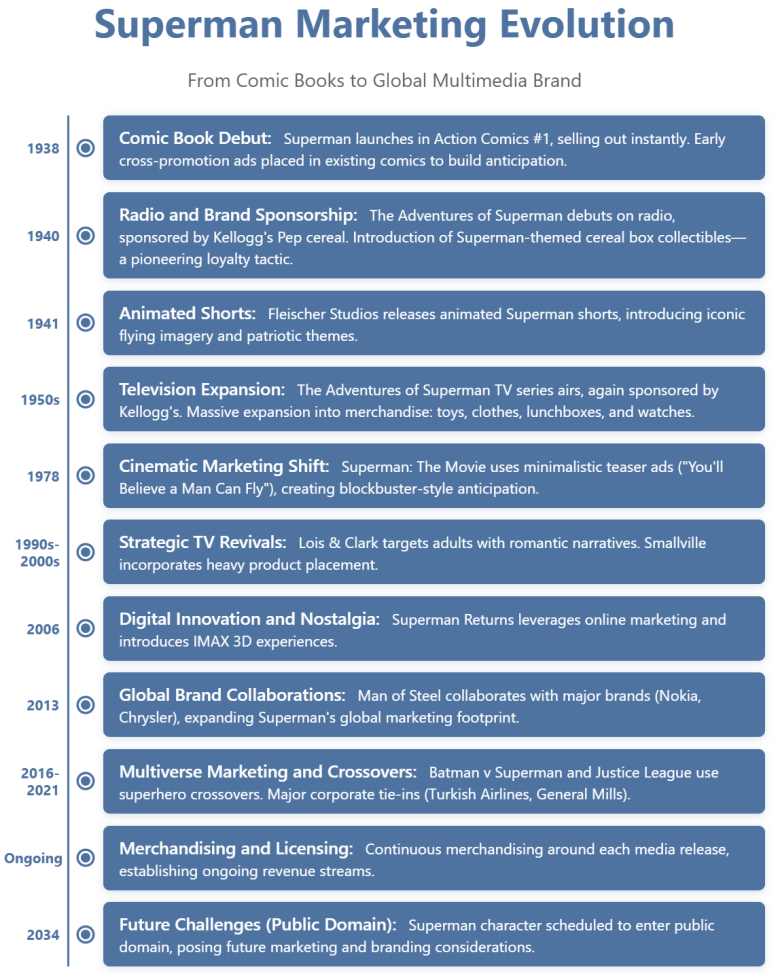
Comic Book Debut
In June 1938, Action Comics #1 hit newsstands with a cover that launched the world’s first true superhero—and a new era of storytelling. The cover image showed Superman hoisting a car above his head like it weighed nothing.
The 10-cent comic sold out all 200,000 copies almost immediately.
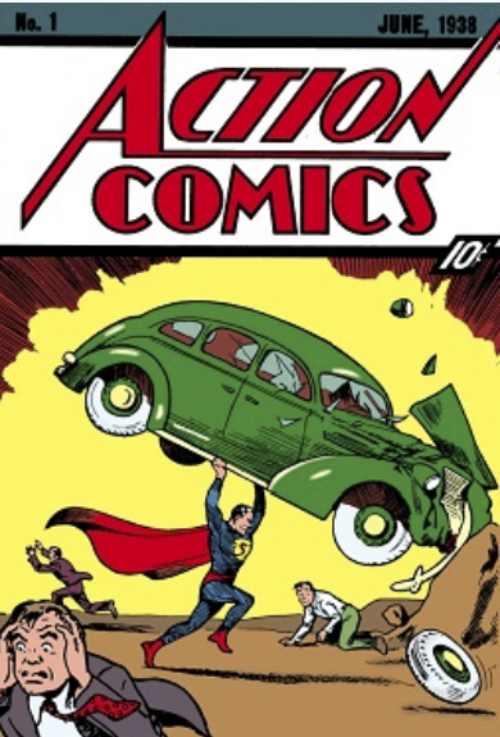
The image that captured America’s imagination wasn’t random. It tapped directly into 1930s anxieties about technology and power, offering readers a hero who could control the very machines that seemed to be controlling them.
It was smart positioning from day one.
National Allied Publications (later DC Comics) quickly deployed cross-promotion tactics that would make modern marketers proud. They placed Superman ads inside their other comic titles like “More Fun Comics,” relying on existing audiences to build anticipation.
Radio and Brand Sponsorship
By 1940, Superman had outgrown comics. Kellogg’s saw an opportunity and sponsored The Adventures of Superman radio serial, creating what might have been marketing’s first cross-media campaign.
In a genius move, Kellogg’s wove Superman into the breakfast experience itself. They placed Superman collectibles into cereal boxes and turned breakfast into a daily brand touchpoint.
Kids begged parents for Kellogg’s not because the corn flakes tasted better, but because Superman was inside.
“The Adventures of Superman” radio show intro, 1940-1951.
The radio show also broke ground by tackling social issues like racism and religious intolerance. In one famous storyline, Superman took on the Ku Klux Klan in a 16-episode series, using real KKK code words and rituals to expose and ridicule the organization.
This values-based marketing expanded Superman’s appeal beyond kids to socially conscious families.
Superman Radio Advice, 1948.
Animated Shorts
In 1941, Fleischer Studios launched animated Superman shorts in cinemas nationwide. They spent a then-astronomical $50,000 per episode (about $1 million in today’s dollars). These high-quality (for their time) animations were cinematic events shown before feature films.
These cartoons introduced elements that became Superman canon: He actually flew (where initially he only leaped), transformed in phone booths, and fought increasingly spectacular villains.
1941 Fleischer Superman Cartoon Trailer.
During World War II, Superman cartoons pivoted to support the war effort. Episodes showed Superman sabotaging Nazi submarines and promoting war bonds. The full-throated values alignment reinforced Superman as America’s hero.
Television
When The Adventures of Superman hit television in 1952, Kellogg’s was ready. Their sponsorship shaped the show’s tone—keeping it wholesome and family-friendly to protect their breakfast brand association.
Superman himself, actor George Reeves, became Kellogg’s spokesman, appearing in commercials that blurred fiction and product endorsement.
George Reeves Kellogg’s commercials, 1950s.
Early Merchandising
During this era, Superman merchandise exploded beyond the cereal box. Toys, clothing, lunchboxes, watches—if kids could carry it, wear it, or play with it, Superman’s shield was probably on it.
By 1960, Superman merchandise generated more revenue than comic book sales, proving that character licensing could be more lucrative than the core product.
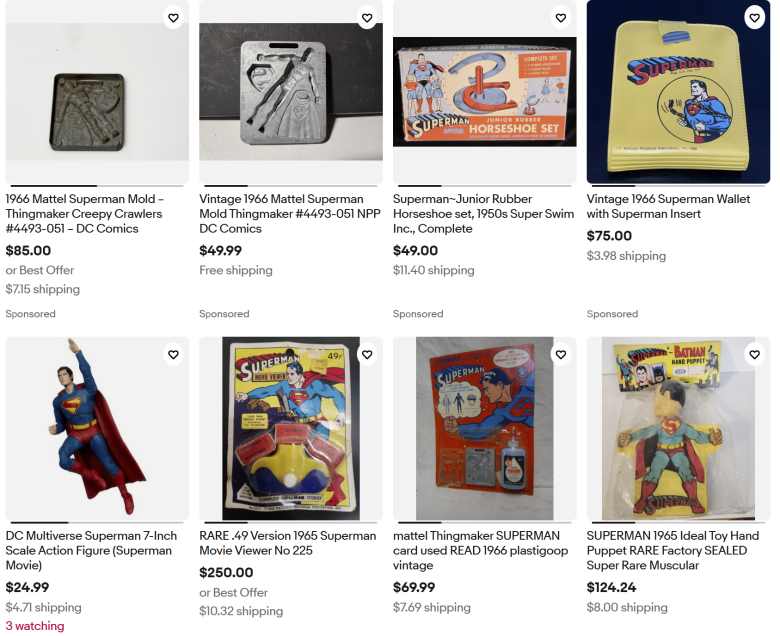
Vintage Superman merchandise is still highly collectible; a selection from eBay.
Cinematic Marketing Shift
Beginning in 1978, Superman made yet another transition: from mythology to multimedia powerhouse. Richard Donner’s Superman: The Movie revitalized Superman after America’s post-Vietnam cynicism.
Warner Bros. promoted the film with simple yet effective messaging: “You’ll believe a man can fly.”
1978 radio ad.
The campaign focused on wonder over plot details. Teaser posters showed only the Superman shield. TV spots emphasized the groundbreaking flying effects. This restraint built mystique—audiences knew something special was coming.
The film grossed $300 million worldwide (about $1.4 billion, adjusted for inflation), proving superhero films could be prestige productions, not just B-movie fare.
This success established the template for modern blockbuster marketing: Build anticipation through strategic reveals, emphasize technical innovation, and promise audiences an experience they’ve never had before.
Official “Superman: The Movie” trailer, 1978.
Television Revivals
After decades of kid-focused content, Lois & Clark: The New Adventures of Superman (1993-1997) repositioned the brand for adults. The show emphasized romance and workplace drama over action, pulling in viewers who’d outgrown Saturday morning cartoons but still harbored Superman nostalgia.
Smallville (2001-2011) took product placement to new heights. Toyota, Stride gum, and Acuvue contact lenses advertised during breaks and appeared in storylines. Clark Kent drove a Toyota Tundra, and the camera lingered on the logo.
This integration generated revenue while adding contemporary realism to the mythology.
Smallville official trailer, 2001
Shared Universes, Shared Audiences
As superhero storytelling evolved, so did the marketing strategy behind it. With the introduction of the DC Multiverse and large-scale crossover films, Warner Bros. took a page from Marvel’s playbook—building interconnected storylines that allowed Superman to anchor, and be elevated by, a broader superhero ensemble.
Superman’s role in Batman v Superman: Dawn of Justice (2016) and Justice League (2017) positioned him not just as a solo icon but as a central figure in a larger heroic ecosystem.
These films drew fans of Batman, Wonder Woman, Aquaman, and others into a shared cinematic universe—bringing their audiences along with them.
“Justice League,” official trailer, 2017.
The Digital Age
In 2006, Superman Returns pioneered digital marketing for superhero films. Director Bryan Singer posted online production diaries, which gave fans behind-the-scenes access that was previously reserved for DVD extras. The film partnered with IMAX to showcase sequences filmed with 3D cameras—technology marketing disguised as storytelling innovation.
Official “Superman Returns” trailer, 2006.
Global Brand Collaborations
Man of Steel (2013) took brand partnerships to new levels. Nokia featured exclusive content on Lumia phones. Chrysler created co-branded commercials. Even German supermarket chain Lidl got involved, proving Superman’s global marketing reach.
These product placements became integrated storytelling experiences across multiple touchpoints.
Official “Man of Steel” trailer, 2013.
Among these strategic alliances, one stood out as a significant step forward in participatory brand engagement.
LEGO and Superman: Building Worlds
LEGO’s partnership with Man of Steel turned merchandising into a creative collaboration. Timed with the film’s release, it positioned Superman sets as storytelling tools.
Fans became co-creators and brand ambassadors. They built custom scenarios and shared them globally. This user-generated content was advertising that money couldn’t buy.
The partnership timing maximized cross-promotional impact. Movie excitement drove LEGO sales; LEGO creativity sustained Superman engagement between films. This symbiotic relationship showed how modern merchandising transcends simple licensing to create participatory brand experiences.
Superman – LEGO DC Universe Super Heroes – Mini Movie.
The Merchandising Machine
Superman merchandise has evolved from tin lunchboxes and action figures to premium collectibles like Lladró’s limited-edition porcelain sculpture in 2025.
But the strategy remains consistent: Offer products for every age, interest level, and price point. A child’s $10 action figure funds the same universe as a collector’s $35,000 Swarovski statue.
Recent innovations include augmented reality experiences and NFTs, proving Superman merchandise can adapt to new technologies while maintaining nostalgic appeal. The character’s visual simplicity—that iconic S-shield—translates perfectly across mediums, from vintage metal signs to smartphone cases.
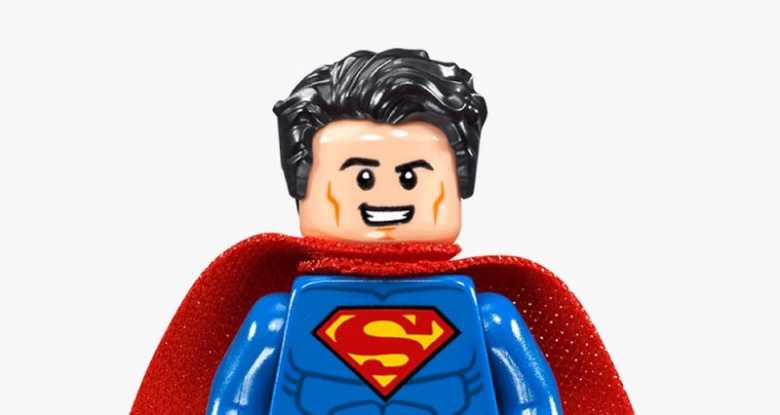
Marketing Moves That Were Way Ahead of Their Time
- Cross-media storytelling. In 1940, the Kellogg’s-sponsored radio show connected comics, audio, cereal boxes, and mail-in premiums into one coordinated brand experience.
- Values-based positioning. The 1946 radio arc exposing the Ku Klux Klan used Superman to promote tolerance—an early example of purpose-driven messaging.
- Merchandise as media. Kellogg’s turned product packaging into story content, with decoder rings, comic panels, and fan club forms built into cereal boxes.
- Character licensing at scale. By the 1950s, Superman-branded merchandise earned more than comics, setting the model for future multibillion-dollar character franchises.
- Event film marketing. Superman: The Movie (1978) teased mystery over plot, using a glowing “S” and promise of flight to generate global anticipation.
- User-generated content campaigns. LEGO’s 2013 Superman sets inspired fan-made animations and builds—early proof that fans could fuel brand storytelling at scale.
- Digital fan engagement. Superman Returns (2006) shared behind-the-scenes content online, giving fans early access before digital exclusives became a norm.
Lessons in Brand Longevity
Superman’s marketing evolution proves that enduring brands aren’t built on single campaigns or clever tactics. They’re constructed through decades of strategic adaptation, authentic cultural connection, and relentless innovation across every available channel.
The Man of Steel didn’t just save Metropolis—he saved marketers a lot of trial and error by showing exactly how to build an unstoppable brand.

Marketer Takeaways
- Adaptability matters. Superman continuously evolves to match societal shifts.
- Integrated storytelling wins. Coordinated narratives across various media strengthen audience engagement.
- Cross-promotion multiplies reach. Leveraging multiple channels amplifies a brand’s presence.
- Authenticity resonates. Superman’s consistent alignment with social values reinforces brand trust.
- Stay agile with trends. Quick responses to cultural shifts (war, social movements, nostalgia) keep brands relevant.
Media Shower’s AI marketing platform helps brands build supercampaigns. Click here for a free trial.
